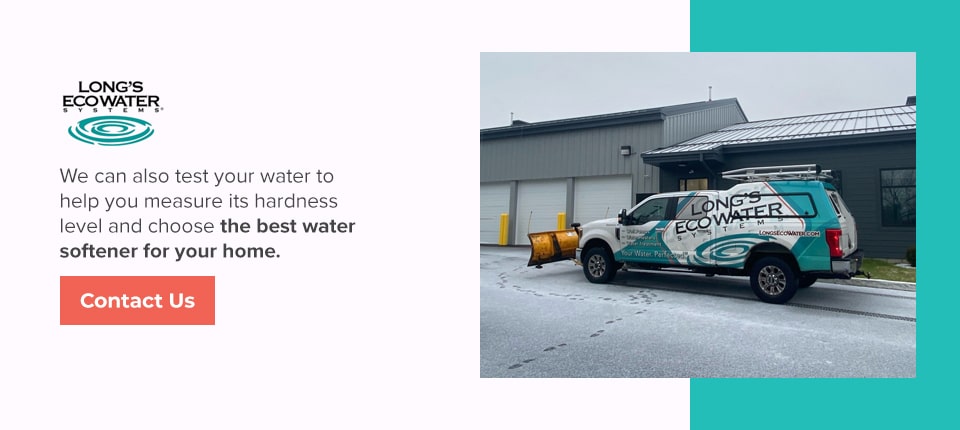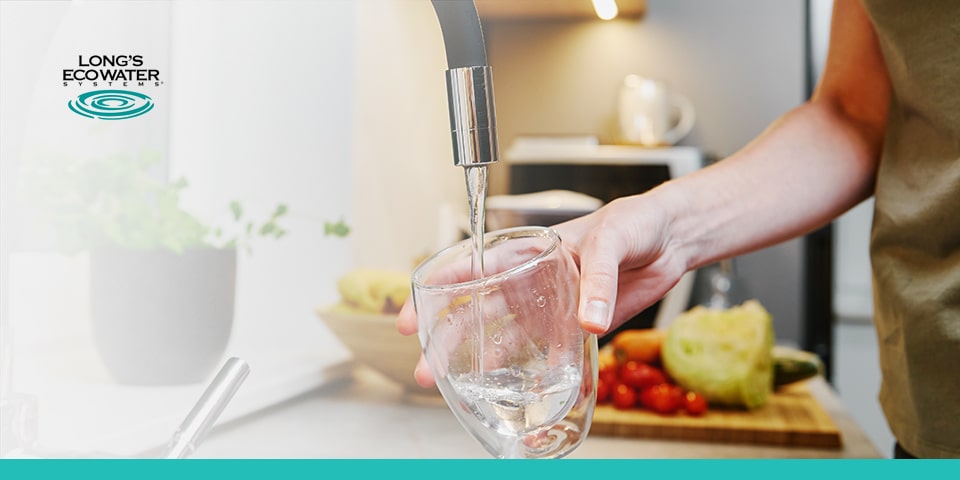
Water softeners benefit homes by removing the minerals in hard water. Hard water deposits minerals on skin, hair, dishes, pipes and water appliances. These minerals are safe to consume, but they can gradually damage your pipes and irritate your skin and hair. Water softeners remove harmful minerals to provide homes with water that’s gentle on surfaces.
Installing a water softener protects your pipes from damage, increasing efficiency and helping water heaters and water fixtures last longer. With a water softener, you can expect improved water pressure, cleaner laundry, softer skin and hair and less scale buildup. Learning how water softeners work can help you understand how they can benefit your home.

What Is the Difference Between Hard and Soft Water?
To understand how water softeners work, you need to know how soft water differs from hard water. Soft water has a low mineral content, and hard water has a high mineral content. Hard water contains high concentrations of magnesium and calcium. While these minerals are daily nutrients, they can have damaging effects in high concentrations.
When water contains high amounts of magnesium and calcium, the minerals can accumulate on contact surfaces, damage water heaters and clog pipes. Scale buildup and mineral deposits can damage water appliances, shorten their life spans and cause faucet leaks.
Hard water is harsh on skin and hair, stripping naturally occurring oils from it. It also decreases detergent and soap effectiveness, forcing household members to use more product to achieve the same level of cleanliness. Soft water is free of magnesium and calcium, making it much gentler on skin, hair, water appliances and laundry.
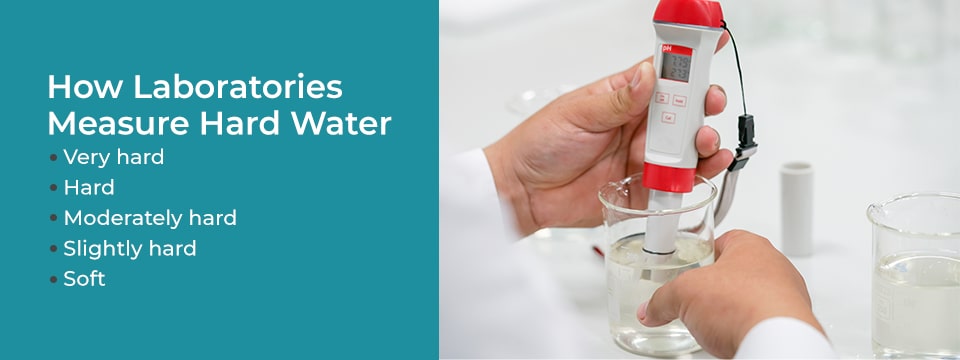
How Laboratories Measure Hard Water
The more magnesium and calcium dissolved in water, the harder the water is. Two measurement units can express water hardness. First, you can measure water hardness in parts per million (PPM), which indicates the water’s dissolved calcium carbonate concentration. For example, a measurement of 2 PPM means two calcium carbonate units are dissolved in 2 million water units.
You can also measure water hardness in calcium carbonate grains per gallon (GPG). GPG exclusively measures water hardness, and 1 GPG is equal to approximately 17 PPM. When a laboratory tests your water, they will use PPM, GPG or both to indicate your water’s level of hardness. To simplify these measurements and make them more useful for water consumers, water specialists classify water hardness into the following levels:
- Very hard: Water classified as very hard has a 10.5 GPG and 180 PPM or higher.
- Hard: Water that falls in the hard category has a GPG between 7.0 and 10.5 and a PPM between 120 and 180.
- Moderately hard: A GPG between 3.5 and 7.0 and a PPM between 60 and 120 indicate that water is moderately hard.
- Slightly hard: Slightly hard water has a GPG between 1.0 and 3.5 and a PPM between 17 and 60.
- Soft: Soft water has a GPG of less than 1.0 and a PPM of less than 17.
What Are Water Softeners?
A water softener system softens hard water by removing magnesium and calcium from a home’s water supply and replacing them with sodium ions. A homeowner can add a water softener to their home’s plumbing where water enters their home, and it will soften the water household members use for washing and drinking. Water softeners improve usable water in homes, but they do not affect the water used for irrigation.
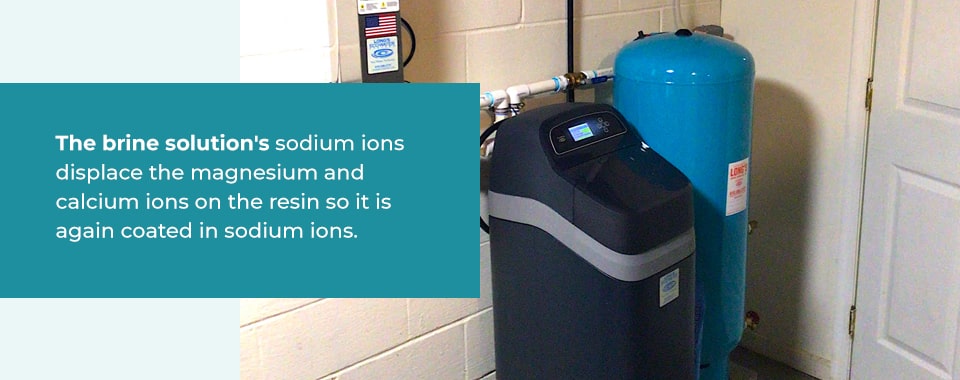
How Do Water Softeners Work?
Water softeners reduce water hardness by removing heavy minerals from a home’s water supply via the process of ion exchange. Ion exchange is when magnesium and calcium exchange position with sodium ions. A water softener system contains porous plastic resin that attracts and traps hard water’s positive ions and releases negative sodium ions. Regeneration cleans the resin as brine water from the brine tank flows back into the water softener’s main tank.
First, hard water flows into the system. The hard water’s positive ions, magnesium and calcium, are attracted to the sodium-charged resin beads within the water softener tank. The resin beads hold sodium and trap the magnesium and calcium. As hard water flows through the resin beads and binds magnesium and calcium to the resin, it displaces the sodium ions. This process forces the hard water’s positive ions to switch places with sodium ions, removing the minerals that create hard water to supply your home with soft water.
A water softener unit periodically renews its resin by rinsing it with sodium chloride, a concentrated saltwater brine solution. This regeneration process typically occurs overnight every few days. Water enters the system’s brine tank and absorbs sodium before entering the main tank.
The brine solution’s sodium ions displace the magnesium and calcium ions on the resin so it is again coated in sodium ions. The system then reverse flushes the salty water with the magnesium and calcium ions down the drain so it can continue normal operation. To prepare the rinse water, homeowners periodically add sodium chloride salt to their water softener unit.
Where Does Water Softener Salt Go?
Most water softener systems use salt to soften hard water with sodium ions and flush calcium and magnesium ions off of the system’s resin. A water softener’s brine tank supplies salt to the system’s main tank when it needs to regenerate the resin. To ensure your tank has the salt it needs to operate properly, you will need to place salt in the brine tank.
Water softeners use salt to add sodium to a home’s water supply, but they do not add salt to the water. The water-softening process breaks down the salt to use its sodium ions, so you can rest assured that your softened water does not have an increased salt content.
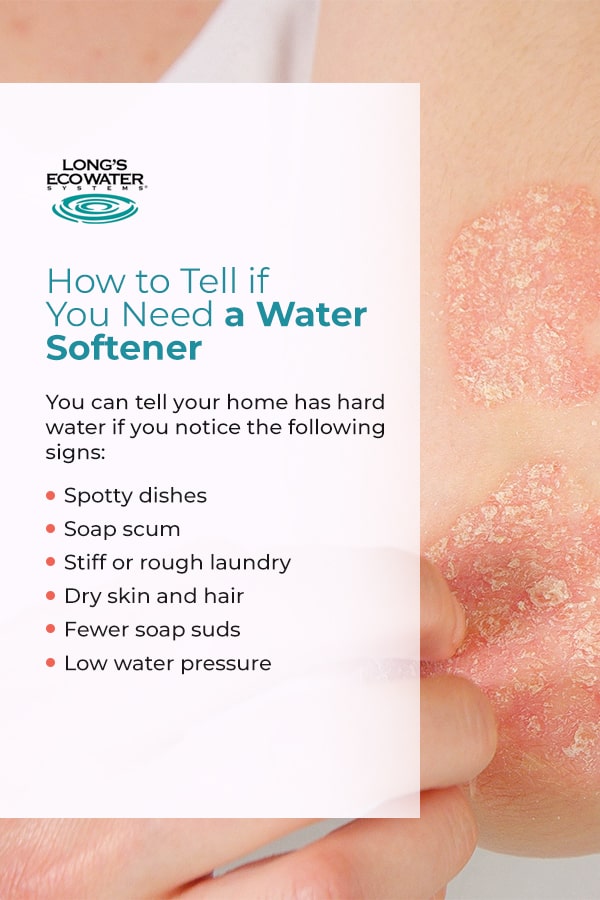
How to Tell if You Need a Water Softener
Water softeners benefit homes with hard water, but determining if your water is hard can be challenging. Hard water typically appears clear and feels similar to soft water. However, it carries minerals that can affect your skin, hair, home, clothes and dishes. You can tell your home has hard water if you notice the following signs:
- Spotty dishes: Washing glassware and dishes in hard water leaves spots as they dry, so you can inspect your clean dishes to determine if hard water may be affecting them.
- Soap scum: Hard water can leave a soap scum film on your bathtub, shower doors and shower walls. Dissolved solids combine with soap to form this film, and it can be difficult to remove.
- Stiff or rough laundry: Hard water interferes with soaps and detergents, so your laundry may feel dull, stiff and grimy after washing it.
- Dry skin and hair: Hard water strips hair and skin of its natural oils, which can leave your skin feeling dry, itchy and rough. You may also notice that your hair feels dry and appears dull, heavy or flat.
- Fewer soap suds: Another sign of hard water is fewer soap suds when you try to lather. Hard water makes it harder to lather soap products such as body wash and shampoo.
- Low water pressure: Mineral buildup can clog pipes, so you may have hard water if you notice low water pressure.
What Are the Benefits of Water Softeners?
Water softeners are incredibly beneficial to homes with hard water. They filter hard water minerals out of water supplies so households can enjoy cleaner, milder water. Hard water is technically safe, but soft water is much gentler on skin, pipes, appliances, dishes and the environment. Adding a water softener to your home provides the following benefits:
Cleaner Dishes and Laundry
Hard water leaves spots on glassware, flatware and dishes when they dry after washing, causing them to look unclean. Softening your water allows you to wash your dishes without leaving spots, making them appear bright and shiny. Soft water also leaves your laundry brighter and cleaner than hard water. Soft water eliminates the residue that hard water leaves on clothes in the washing machine, which helps fabric last longer and come out softer.
Softer Skin and Hair
Soft water is much gentler on your skin and hair than hard water. Hard water leaves some minerals behind on your skin and hair, which can strip it of its natural oils and dry it out. These minerals also make it harder to rinse off soap and shampoo, which can increase dryness and irritation.
After installing a water softener in your home, you may notice that your skin feels more hydrated, clean, smooth and healthy after showering and washing your hands. You may also find that your hair feels and appears silkier with less breakage.
Damage Prevention
While you may notice some signs of hard water in your home, other signs may go unnoticed until damage occurs. Heated hard water deposits dissolved solids that settle on surfaces when they are suspended. The dissolved solids then create a mineral deposit that accumulates in the bottom of your water heater. This buildup can shorten your water heater’s life span and increase its energy consumption. The more scale that accumulates in the water heater, the more energy the water heater needs to heat water for your home.
Scale can also accumulate in your water appliances such as your shower, dishwasher, washing machine, refrigerator and coffee pot. This buildup can eventually create clogs, hinder water flow and damage pipes, leading to leaks and potentially costly repairs.
Efficiency
A water softener can save your household money. Hard water typically requires you to use more soap, dishwashing liquid and detergent to clean your skin, dishes and clothes. When soap or detergent reacts with hard water, it bonds with the calcium to create sticky clumps, so you need to use more soap or detergent than is typically necessary to clean effectively. These clumps also attach to fabric in the washer and trap dirt in your clothes, making them feel grimy when they come out.
Soft water allows you to clean your body, fabrics and dishes effectively with a smaller amount of cleaning agents. Using less soap and detergent can save your household a significant amount of money over time.
Soft water can also reduce your energy use. Decreasing the scale buildup in your home’s pipes reduces the energy your water heater consumes to heat the water.
Safer Environmental Impact
Soft water is much safer for the environment than hard water. Since soft water allows you to clean with smaller amounts of cleaning agents, it reduces the amount of soap and detergent that goes down your drains and enters your community’s water system and groundwater.
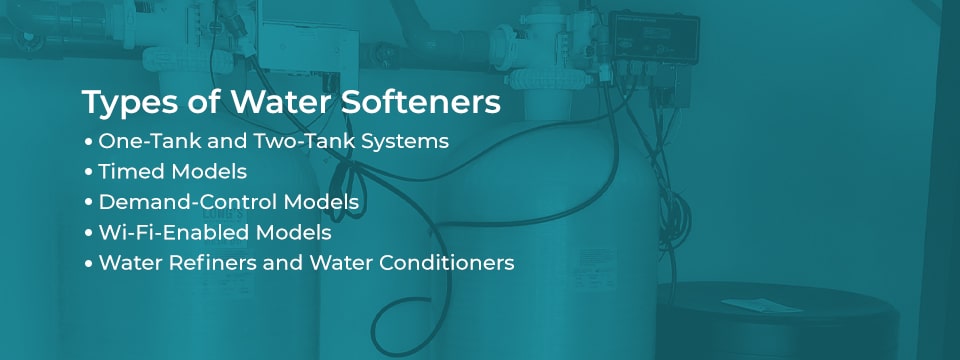
Types of Water Softeners
While most water softeners operate similarly, you do have some options you can choose from. Depending on your home’s water softening needs, you can choose between a one-tank and two-tank system, and you can decide if you want a timed model or a demand-control model. You can also choose a system with Wi-Fi-enabled features for optimal monitoring and maintenance.
One-Tank and Two-Tank Systems
A one-tank water softener system contains its brine tank inside its salt tank. Since the brine tank nests inside the salt tank, this type of system requires less space. A two-tank system contains a separate salt tank and brine tank, which provides homeowners with more options for their system’s hard water capacity.
Timed Models
Timed water softener models contain programmable time clocks to operate on a fixed schedule. This allows them to regenerate at predetermined times and automatically resume normal operation after reverse flushing the resin. Timed models typically consume more water and salt because they regenerate whether the system needs to flush or not, but they work well in households that regularly use water.
Demand-Control Models
Demand-control water softener models contain mechanical or electrical sensors. These sensors detect when a system softens a certain amount of water and signal it to regenerate automatically once it softens so many gallons. This type of water softener is ideal for households that use water on a fluctuating schedule.
Wi-Fi-Enabled Models
Wi-Fi-enabled water softeners are easy to monitor and maintain. If you have a Wi-Fi-enabled system, you can receive important notifications such as the following:
- Continuous water use
- Excessive water use
- Low salt alerts
- System errors
- Service reminder alerts
Water Refiners and Water Conditioners
Water refiners and water conditioners soften hard water, but each type of system offers different additional benefits. A water refiner is ideal for households with public water because it also removes chlorine, and a water conditioner is an excellent choice for homes with well water because it removes manganese, iron and sediment. A water professional can help you determine the best option for your home with a water test.
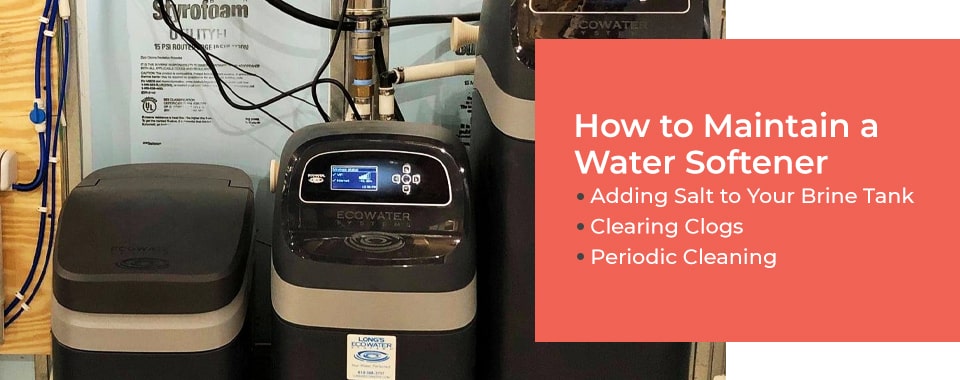
How to Maintain a Water Softener
Water softener systems operate and regenerate automatically, but they require some simple maintenance to remain functional and efficient. You can maintain your water softener unit with the following maintenance procedures:
Adding Salt to Your Brine Tank
A water softener’s brine solution is made of salty water that effectively reverse-flushes magnesium and calcium ions from the system’s tank. While water softeners automatically regenerate on timed schedules or when they detect the system has softened a specific number of gallons, you must add the salt to the system so it can repeat this cycle.
After a regeneration cycle, the brine tank should contain some water. However, you should add salt to the tank anytime the standing water level is above the salt. When you can see standing water, add a bag of salt to the brine tank until you no longer see the water.
Avoid overfilling the brine tank with salt because too much salt can become too heavy for the tank and cause long-term damage. Only fill the tank until it covers the standing water and leave the space above the salt empty.
How often you need to add salt to your tank depends on how much water your household typically uses, your water softener’s size and how often it regenerates. Most homeowners need to check their brine tanks once a month.
Clearing Clogs
A water softener’s resin can clog periodically. Backwashing sometimes removes clogs, but you may need to slowly stir the resin while it backwashes to break up material and remove clogs in some cases.
Periodic Cleaning
Periodic cleaning also helps your water softener operate effectively and last longer. Fungi and bacteria can accumulate in a water softener tank, so it’s important to clean the water softener or disinfect water before it enters the softener. You can clean your water softener with the following steps:
- Empty the salt and water from the system’s brine tank.
- Use warm soap and water to scrub the inside of the brine tank and its interior components until each part is clear of brine residue.
- Use a water and bleach solution free of additives to clean the brine tank and its components before rinsing it with clean water.
- Fill the brine tank with clean water, additive-free salt and three teaspoons of additive-free bleach.
Never mix bleach with resin bed cleaners, salt with additives or red-out salts. Mixing these chemicals can produce harmful fumes. After cleaning your brine tank, you can clean your water softener’s resin with the following steps:
- Place the unit in backwash mode to flush the water softener.
- Allow the water to drain for 10 minutes or until it runs clear.
- Pour 2 ounces of bleach for each cubic foot of resin media into the brine tank.
- Rinse the brine tank’s components to prevent corrosion.
- Initiate the system to regenerate immediately to allow the chlorinated brine solution to enter the unit and flow through the resin.
- After the regeneration process is complete, run cold water in one of your home’s water supplies.
- If chlorine remains in the water, allow it to flow until it clears.
- Test your water with a certified laboratory to ensure it is clean and safe.
Long’s EcoWater Systems, Inc. Water Softeners
A water softener uses sodium ions to remove magnesium and calcium from hard water, making your water safer and gentler for your home, skin, hair, dishes and laundry. Long’s EcoWater Systems installs and repairs EcoWater water softeners in the Greater Lehigh Valley and eastern Pennsylvania area to improve your home’s water quality.
We can also test your water to help you measure its hardness level and choose the best water softener for your home. Contact us to learn more about EcoWater Water Softeners or schedule a water test to determine the best options for your household.



